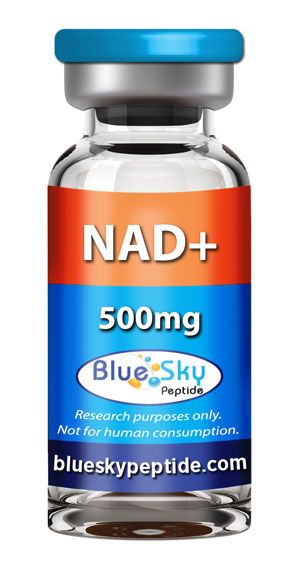60% Off Your Order*
Our Biggest Sale of the Year!!

Availability: In stock

| Unit Size | 500mg/vial |
| Unit Quantity | 1 vial |
| Purity (Mass Spectrometry and UV) | 99.82% |
| Sequence | N/A |
| Molecular Formula | C21H27N7O14P2 |
| Appearance | Lyophilized White Powder |
| Source | Chemical Synthesis |
| Storage | Lyophilized NAD+ is stable at room Temperature for 90 days, however it is best to store in a freezer below - 8c for any extended period of time. |
| Terms | The products we offer are intended for laboratory research use only. Please familiarize yourself with our terms of service prior to ordering. |
NAD+ 500mg (Nicotinamide Adenine Dinucleotide) is a coenzyme present in all living cells and plays a central role in cellular energy production and metabolism. NAD+ is essential for metabolic processes as it participates in redox reactions, serving as a crucial electron transporter in the mitochondrial electron transport chain (ETC), which generates ATP — the energy currency of cells. As cells age, NAD+ levels decline, which has been associated with metabolic dysregulation and age-related cellular damage.1
This NAD+ 500mg product is intended exclusively for in vitro laboratory research and is not approved for human or veterinary use. Laboratory research into NAD+ includes its role in cellular energy production, DNA repair, and aging studies, making it a valuable component in scientific investigations exploring metabolic and age-related conditions. NAD+ supplementation in vitro has been linked to improvements in mitochondrial function and cellular energy efficiency, which are essential areas in metabolic and longevity research.2
Key Research Areas for NAD+ in In Vitro Studies
1. Cellular Energy Production
In vitro studies on NAD+ have provided insights into its role in cellular energy metabolism. NAD+ is a key player in glycolysis, the citric acid cycle, and oxidative phosphorylation — critical metabolic pathways that generate ATP in cells. Research suggests that increasing NAD+ availability can enhance mitochondrial function, potentially counteracting the decline in cellular energy associated with aging.3 This aspect of NAD+ is of particular interest for studies focused on age-related metabolic decline and mitochondrial dysfunction, as NAD+ appears to support energy-intensive cellular processes.4
2. DNA Repair and Cellular Health
NAD+ also plays a significant role in DNA repair processes, functioning as a substrate for enzymes like PARPs (Poly ADP-ribose polymerases) and sirtuins. These enzymes are activated in response to DNA damage and have been associated with longevity and improved cellular health in preclinical models.5 Sirtuins, a class of NAD+-dependent enzymes, are involved in chromatin regulation and gene expression, with studies suggesting their role in reducing inflammation and oxidative stress in cells. By replenishing NAD+ levels, in vitro research has shown potential improvements in cellular repair mechanisms, which may slow cellular aging and promote genome stability.6
3. Neuroprotection and Cognitive Research
Research into NAD+ has also extended to neuroprotection studies, where NAD+ availability appears linked to the maintenance of neuronal health and function. NAD+ has been shown to support axonal integrity and protect against neurodegeneration in in vitro research involving neuronal cells.7 Due to its role in energy metabolism and DNA repair, NAD+ is a promising target for studies on neurodegenerative conditions, which are often characterized by mitochondrial dysfunction and cellular damage.8
Product Information
This NAD+ 500mg product is supplied as a white, lyophilized powder specifically for in vitro laboratory research. It is not intended for use in humans or animals. Research on NAD+ in laboratory settings continues to reveal its potential in supporting cellular health, energy production, and DNA repair mechanisms. This product must be handled in accordance with safety protocols specific to laboratory reagents and should only be used in controlled research environments.
References